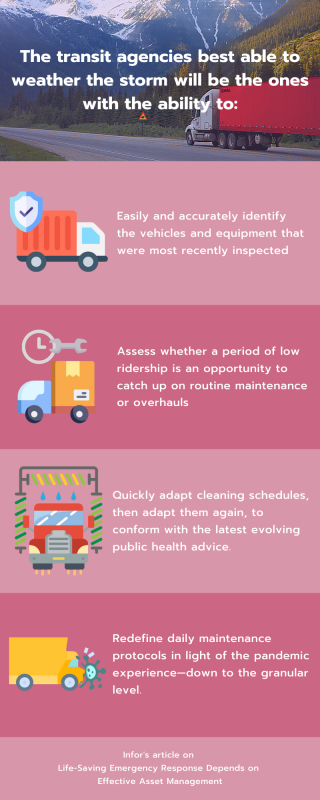Effective emergency preparedness depends on the ability to track and manage every physical asset and human resource at your disposal.
Getting It Down to a Science
At the first sign of trouble, well-prepared communities roll out the pre-packaged sets of work orders, purchase agreements, contractor engagements, personnel, and equipment that will help them prepare for an oncoming disaster. As the danger gets closer, they pull the trigger on an integrated, carefully considered set of projects and sub-projects.
If it’s a matter of having all infrastructure in peak operating condition before disaster strikes, they have real-time maintenance records to identify the parts that need immediate attention. If it’s a situation assessment to flag vulnerabilities, they have sensor and physical inspection data to allocate resources.
As the response and recovery unfold, each action, piece of equipment, and supply can be carefully tracked with monitoring systems already in place
This means that the agency can easily compile its expenses for federal reimbursement, deliver an after-action report to stakeholders, forthrightly and transparently assess what worked best.
An Integrated Response for Transit Agencies
The COVID-19 pandemic is the most immediate example of an all-encompassing disaster that calls for an organized response from transit operators. The scope of the challenge is reflected in the frequently asked questions pages of the Federal Transit Administration.
The agencies best able to weather the storm will be the ones with the ability to:
Easily and accurately identify the vehicles and equipment that were most recently inspected;Assess whether a period of low ridership is an opportunity to catch up on routine maintenance or overhauls;Quickly adapt cleaning schedules, then adapt them again, to conform with the latest evolving public health advice;Redefine daily maintenance protocols in light of the pandemic experience—down to the granular level.
In any emergency, and certainly one on the scale of the pandemic, there’s the risk that critical supply chain data simply won’t be captured. With new equipment flooding the system, much of it donated, the priority is to get the incoming gear out into the field— but if it isn’t registered in inventory, the agency loses the ability to track its use, effectiveness, operating condition, cost, or disposal.
In the present crisis, the focus is on personal protective equipment. In a physical disaster, the priority might be different. But whatever the details, an emergency is an extreme example of the maxim that you cannot manage what you cannot measure. In this case, if you do not know an item is there or where to find it, you cannot track it for any practical purpose.
Building Back Better
Systems of all kinds, including transit, can learn and improve over time if they are also set up to build back better.
That begins with a close look at an agency and its infrastructure before the pandemic hit, then documenting its response during the crisis and getting a clear-eyed view of where it stands. The details will have to be as granular as the readiness of specific assets and their ability to operate under duress, the personnel protocols that enabled workers to operate in “clean” mode, transparency on supply chains and materials, and interactions with key contractors.
There will be opportunities to explore these questions as U.S. transit agencies begin to receive recovery funding under the federal Coronavirus Aid, Relief, and Economic Security (CARES) Act. Agencies will be able to conduct after-action assessments, anticipate future problems, react to changing expectations, and understand obstacles to better performance. And it remains to be seen whether the FTA itself will respond by shifting its standards of operation or State of Good Repair performance measures to capture lessons learned from the pandemic.
Wherever the changes occur, any emergency engagement is an important moment to celebrate successes, identify gaps, and pursue a basic commitment to continuous improvement. That necessarily includes getting the administrative and IT systems in place that make it all possible.

